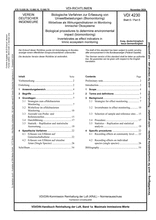
Technical rule [CURRENT]
VDI 4230 Blatt 6:2024-11
Biological procedures to determine environmental impact (biomonitoring) - Invertebrates as effect indicators in limnic ecosystem monitoring
- German title
- Biologische Verfahren zur Erfassung von Umweltbelastungen (Biomonitoring) - Wirbellose als Wirkungsindikatoren im Monitoring limnischer Ökosysteme
- Publication date
- 2024-11
- Original language
- German, English
- Pages
- 63
- Publication date
- 2024-11
- Original language
- German, English
- Pages
- 63
Product information on this site:
Quick delivery via download or delivery service
Buy securely with a credit card or pay upon receipt of invoice
All transactions are encrypted
Short description
For the holistic monitoring of the status of inland waters (limnic ecosystems), the use of animals as bioindicators is useful in addition to chemical-analytical investigations. In this way, environmental pollution can be detected at the effect level, taking into account all input pathways into water bodies, including atmospheric deposition. The standard describes the procedure for effect-based biomonitoring: the specific requirements for sampling and the subsequent investigations in the laboratory for defined endpoints (biomarkers). The indicator organisms are predominantly native aquatic invertebrates (e. g. mussels, crustaceans and nematodes). Possible areas of application of the standard are permanent water monitoring, localisation of discharges, evaluation of water management measures, monitoring of accidents/peak exposure and monitoring of known hotspots. The standard is intended as a guideline for authorities in particular.
Content
ICS
13.020.30,
13.060.10,
13.060.70
Also available in
Loading recommended items...
Loading recommended items...
Loading recommended items...
Loading recommended items...

